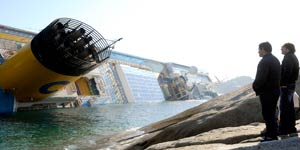AARP Hearing Center
Don't Abandon Ship! Why the Costa Concordia Disaster Should Not Keep You Ashore
By Bill Newcott, January 17, 2012 10:02 AM

For most cruise passengers, the mandatory lifeboat drill is about as welcome as a case of sea sickness. The captain sounds the muster signal on that big honkin' boat horn (seven short beeps, then one long), you head back to your cabin, pick up your life vest, and then join that endless stream of grumbling-yet-gaily-attired passengers, stumbling through narrow corridors and down stairways to your designated station. It's time consuming, it's boring, and you have to watch out not to trip over the vest straps being dragged along by the guy ahead of you.
There's also a nagging sense of betrayal: For months, that cruise line you're on has been luring you to sea with glitzy TV and magazine ads that feature smiling people lazing by the pool, sipping rum punches on their balconies, and dancing in ocean-going nightclubs. Now you're barely out of port and that same company is muttering under its breath, "Oh, yeah, by the way, you could die out here..."
Of course, in the wake of those awful images of the Costa Concordia lying on its side off the coast of Tuscany, lifeboat drills are about to get a whole new lotta respect from both cruise ship passengers and crews. And TV newscasters, never ones to let a good scare go unexploited, are already staring earnestly into their cameras and solemnly intoning, "Are cruise ship passengers walking the plank ... to their doom???"
So it's time for a reality check: Other than walking, can you think of a mode of transportation that's safer than cruising? The simple fact that the wreck of the Costa Concordia is burned into our consciousness speaks to the absolutely macabre novelty of it. When I was a kid my mother still shuddered at the memory of seeing the cruise ship Morro Castle beached off Asbury Park, N.J., after a deadly fire in 1934. And survivors still set wreaths adrift off Nantucket, where the Andrea Doria sank in 1956.
So it appears that cruise ship disasters are a generational thing - every few decades, some captain does something stupid, or some infallible system fails, and then here we are riveted to CNN, watching useless lifeboats resting on the side of a listing superliner.
The trouble with cruise ship disasters is the scale of them. When a bus runs off a highway, dozens of lives are in danger. When a plane goes down, a couple of hundred people are at risk. But when an unexpected rock tears a hole in the side of a cruise ship carrying the equivalent population of a small town, the implications are staggering. Add to that the Conocoria's uniquely European dilemma - thousands of passengers and crew who did not share a common language - and the possibilities of chaos are multiplied.
There's no reason why you should cancel your upcoming cruise, nor should anyone who's contemplating a vacation at sea let the Concordia disaster in any way discourage them. Still, the skittish might want to consider a few tips to ensure peace of mind:
- Choose a cruise line that has your language as its native tongue. That's no problem if your language is English and you're sailing from a U.S. port - and don't let the ship's registry cause you undue alarm. Almost no ships are of U.S. Registry. Bahamas registry is by far the most common, followed by Panama and Bermuda (which, under maritime law, is one of the few registries that allows ship captains to perform weddings at sea). The predominant language of a cruise ship is determined by the target passenger pool, and if you sail from the U.S., that pool is nearly always English speaking.
- Call the cruise line's toll-free number and ask up front: Do you perform lifeboat drills before you leave port?
- When you get on board, plan to do the standard drill one better. On most larger ships these days, "lifeboat drills" have been replaced by "muster drills," in which passengers are asked to go not to their lifeboat locations, but to a larger gathering spot - a theater or dining room - from which they would be led to their lifeboats in a real emergency. After the drill, ask a crew member where your actual lifeboat is and later, on your daily promenade around the deck, check it out for yourself.
- Be a woman or a child (they really do get to go first!).































































